20th-Century Arnis
The Reemergence of a Warrior's Art
(Part 3)
By Mark V. Wiley
As human nature usually has it even the best of intentions go awry. During
the course of the revival of Filipino martial arts many of the schools
became rivals and their members would fight against one another to see
who was superior. However, in the hope of once again promoting solidarity
amongst fellow practitioners and schools in Cebu, the Cebu Escrima Association
was formed in 1976. The newly formed Association lost no time in perpetuating
the arts and that same year, in association with NARAPHIL, it sponsored
the First National Arnis Convention and First Asian Martial Arts Festival.
Then, in 1977, in Talisay, Cebu, Grandmaster Florencio Lasola founded
the Oolibama Arnis Club.
Perhaps the most successful association in the central and southern Philippines
in the 1970s was the Tres Personas Arnis de Mano Association. Tres Personas
was founded by Timoteo E. Maranga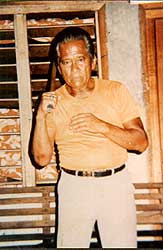 with
four specific goals in mind: to promote brotherhood and understanding
among the advocates of Filipino martial arts; to encourage and propagate
Filipino martial arts among the youth; to defend the weak, the young and
the old; and to defend the oppressed people, country, and God. Maranga's
martial arts background is varied and includes studies in combat arnis,
judo, karate, and Western wrestling. Tres Personas arnis is a mixture
of the de marina, de cadena, literada, Batangueña serada, florete,
and sumbrada styles. with
four specific goals in mind: to promote brotherhood and understanding
among the advocates of Filipino martial arts; to encourage and propagate
Filipino martial arts among the youth; to defend the weak, the young and
the old; and to defend the oppressed people, country, and God. Maranga's
martial arts background is varied and includes studies in combat arnis,
judo, karate, and Western wrestling. Tres Personas arnis is a mixture
of the de marina, de cadena, literada, Batangueña serada, florete,
and sumbrada styles.
In the United States in 1977, Dan Inosanto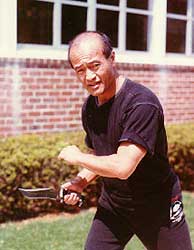 published
The Filipino Martial Arts. Although not the first book on the arts published
in English, it was the most widely distributed and well-rounded. Inosanto's
early pioneering efforts to expose different Filipino masters and systems
is reflected in this work. Then, in 1978, Kyokushin-kai karate instructor
Ben Singleton sponsored the Pro-Am Classic tournament in Vista, California.
This tournament featured the first full contact open weapons sparring
division in the United States. Narrie Babao, a student of Carlito A. Lañada
and Dan Inosanto, took first place. On March 24, 1979, the National Arnis
Association of the Philippines sponsored the First Open Arnis Tournament
in Cebu City, where Tom Bisio reigned as champion. Then, on August 19,
NARAPHIL sponsored the First National Invitational Arnis Tournament in
Manila. Among the masters who par-ticipated in the "masters sparring
division" were Cacoy Cañete from Cebu, Timoteo Maranga and
Alfredo Mangcal from Mindanao, Jose Mena, Benjamin Luna Lema and Florencio
Pecate from Manila, and Hortencio Navales from Negros Occidental. In Both
tournaments Cacoy Cañete reigned as champion. Interestingly, the
most infamous master, Antonio Ilustrisimo, published
The Filipino Martial Arts. Although not the first book on the arts published
in English, it was the most widely distributed and well-rounded. Inosanto's
early pioneering efforts to expose different Filipino masters and systems
is reflected in this work. Then, in 1978, Kyokushin-kai karate instructor
Ben Singleton sponsored the Pro-Am Classic tournament in Vista, California.
This tournament featured the first full contact open weapons sparring
division in the United States. Narrie Babao, a student of Carlito A. Lañada
and Dan Inosanto, took first place. On March 24, 1979, the National Arnis
Association of the Philippines sponsored the First Open Arnis Tournament
in Cebu City, where Tom Bisio reigned as champion. Then, on August 19,
NARAPHIL sponsored the First National Invitational Arnis Tournament in
Manila. Among the masters who par-ticipated in the "masters sparring
division" were Cacoy Cañete from Cebu, Timoteo Maranga and
Alfredo Mangcal from Mindanao, Jose Mena, Benjamin Luna Lema and Florencio
Pecate from Manila, and Hortencio Navales from Negros Occidental. In Both
tournaments Cacoy Cañete reigned as champion. Interestingly, the
most infamous master, Antonio Ilustrisimo,

refused to compete under the tournament's rules. In response, Ilustrisimo
made the statement: "If anyone wants to take my reputation, they
will have to fight me with a sword." There were no challengers.
The 1980s saw a number of tournaments sponsored to further establish
arnis as a sport. On March 16, 1985, the Third National Arnis Tournament
was held in Cebu City, and the Fourth National in Bacolod City on July
26, 1986. Then, on January 2, 1987 Dionisio "Diony" Cañete,
the nephew of Cacoy Cañete, was elected as the new president of
NARAPHIL. From May 26-29, 1989, the Philippine Kali Grand Championship
was held in Manila. Both events were jointly sponsored by the Kali Association
of the Philippines and the Armed Forces of the Philippines. In response
to the world wide spread of Filipino martial arts the World Kali Eskrima
Arnis Federation (WEKAF) was founded in 1987 in Los Angeles, California,
with Dionisio Cañete as its first president. The First United States
National Eskrima Kali Arnis Championships was then held in San Jose, California
in October of 1988. The First Eastern USA Eskrima Kali Arnis Championships
was then held in New Jersey in May of the following year. Then, on August
11-13, 1989, WEKAF sponsored the First World Kali Eskrima Arnis Championships
in Cebu, Philippines.
One of the best-known grandmasters of arnis in the Western world is Remy
Presas.
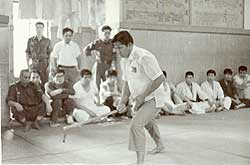
Presas first gained popularity in the United States in 1983, with th
epublishing of his third book, Modern Arnis: Filipino Art of Stick Fighting.
As a result of this book, Presas became known as the "Father of Modern
Arnis," and has since been featured on the cover of numerous martial
arts magazines, produced six instructional video tapes, and has a larger
base of students around the world than any other single Filipino master.
In 1991, Arnis Philippines became the "official" government-sponsored
organization to spread the art of arnis. Arnis Philippines then became
the thirty-third member of the Philippine Olympic Committee. Through this
organization's efforts Arnis was featured as a demonstration sport in
the 1991 Southeast Asian Games (SEA Games). Arnis Philippines then formed
the International Arnis Federation which brought thirty countries together
to work towards the acceptence of asnis as a demonstration sport in the
Olympic games. With arnis now the national sport of the Philippines, the
Senate Committee on Youth and Sports Development, the Philippine Sports
Commission, and the Philippine Olympic Committee jointly sponsored and
endorsed the Grand Exhibition of Martial Arts in Manila. The event, held
on July 31, 1993, featured demonstrations by practitioners of arnis Lanada,
sikaran, kali Ilustrisimo, sagasa, ngo cho kun, pencak silat, hwarangdo,
hsing-i, and kyokushin-kai.
The 1990s also saw many other masters coming out of the woodwork to teach
or further promote their arts.
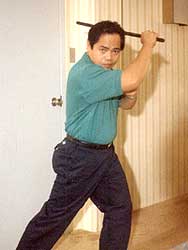
Included in this group would be the late founder of lameco eskrima, Edgar
Sulite,
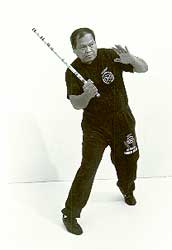
Balintawak arnis cuentada master Bobby Taboada,
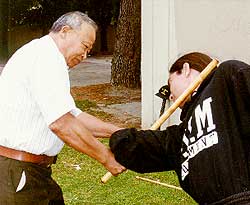
arnis and hilot master Sam Tendencia, and

Rigonan-Estalilla kabaroan grandmaster Ramiro Estalilla.
The 20th-century has seen a revival of martial arts in the Philippines
paralleled by no other country. In the past sixty years the arts went
from almost complete isolation and obscurity to world wide exposure and
commercialization. With this exposure, and paralleling the ethnic, tribal,
and religious separateness in the Philippines, have sprung a plethora
of new organizations and associations, new schools and styles, new masters
and grandmasters. What the Filipino martial arts needs if they are to
remain through the next century is a stronger sense of cohesion. One organization
must be crafted to accommodate the various martial ideologies. A single
ranking structure must be adopted to assure a high standard for and legitimization
of rank among and between systems and styles. This must happen without
losing sight of the roots of the arts which commercialization tends to
do.
In closing, the words of Leonard B. Meyer are fitting:
"New styles and techniques, schools and movements, programs and
philosophies, have succeeded one another with bewildering rapidity. And
the old has not, as a rule, been displaced by the new. Earlier movements
have persisted side by side with later ones, producing a profusion of
alternative styles and schoolsóeach with its attendant aesthetic
outlook and theory."
About the Author
Mark Wiley is an accomplished martial artist and leading authority
on a variety of Philippine and Chinese martial arts, French savate,
tae kwon do and karate. He is the author of three books on Phillippine
martial arts, including Filipino Martial Culture, from which this article
was in part excerpted. He has served as Martial Arts Editor for Charles
E. Tuttle Publishing Co., Book Publishing Editor for Unique Publications,
Editor of Martial Arts Legends magazine and Associate Editor for the
Journal of Asian Martial Arts. He is author of eight books on martial
arts and qi gong and over 100 articles published in a variety of martial
arts magazines. He also serves as Associate Editor for FightingArts.com.
|